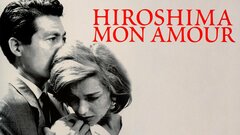Arguably the single most important director to emerge from the French New Wave, Alain Resnais fed his early imagination a varied diet of popular movies, pulp fiction, Proust, Katherine Mansfield and comic books, retaining throughout his career the ability to bridge the gap between high and low culture in his films.
He began making 16mm documentary "art" shorts in the late 1940s, visiting the works of Hans Hartnung, Felix Labisse, Henri Goetz and Max Ernst, among others, but it was his more ambitious "Van Gogh" (1948) which finally succeeded in truly drawing the observer into the artist's world. The film impressed producer Pierre Braunberger sufficiently that he requested Resnais film a 35mm version which earned the 1949 Best Short Subject Oscar. With "Guernica" (1950), a short directed in collaboration with Robert Hessen, the former editor took his filmmaking one step farther, employing the montage techniques he had gradually been mastering to create a passionate protest against war that is at the same time an affirmation of faith in humanity and the possibility of love.
The director's subsequent move into feature films was equally acclaimed, resulting in some of the most powerful and emotionally resonant films of their time. Considered an auteur despite his reliance on collaborating screenwriters, Resnais consistently adhered to strategies of fragmented point-of-view and multiple temporality and has significantly advanced film's ability to express the vagaries of the human mind.
Resnais' most memorable documentary is the 31-minute "Nuit et brouillard/Night and Fog" (1956), a disturbing excursion into the world of Nazi concentration camps, in which he first revealed his preoccupation with the theme of memory and a visual style emphasizing probing camera tracking. Called by then-critic Francois Truffaut the greatest film ever made, it carefully juxtaposed black-and-white stills and newsreel footage depicting the obscenities that once transpired with restless color tracking shots of the post-war locations of those crimes. The poetic refrain of the narrator--"Who is responsible?"--forces viewers to confront the Holocaust as a continuing potentiality. The endless stacks and corridors of the Bibliotheque National in Resnais' subsequent "Toute la memoire du monde" (1956), his lyrical documentary about the great library, lent themselves particularly well to long tracking shots, and "Le Chant du styrene/The Styrene Song" (1958), which traced plastic back to its primeval beginnings, allowed him to experiment with editing to increase the feeling of speed for its own exciting sake.
Considered by many the first masterpiece of the French New Wave, Resnais' debut feature, "Hiroshima, Mon Amour" (1959), won the International Critics Prize at the same Cannes Film Festival that named Francois Truffaut best director for "The 400 Blows." Expanding on the stylistic experiments begun with "Night and Fog," this collaboration with screenwriter Marguerite Duras detailed the affair between a Japanese man and a French actress who had come to Hiroshima to make a film about the atomic holocaust. Particularly notable is the long opening sequence which combines the images of the nude, intertwined lovers with horrific documentary footage of the aftermath of the bombing. Resnais' montage allows him to travel from one place to another and from the "present" to a variety of past times, marrying the private moments of the two principals with the very public tragedy of Hiroshima. In addition to its revolutionary editing, the film was also innovative in its elevation of sound as a vital component independent and often contrapuntal to the visual images.
Setting out to capture the "stream of consciousness" technique of the modern novel, Resnais conceived a completely plotless narrative that was a subjective recreation of the past in the memory of the protagonist for his next film, "L'Annee derniere a Marienbad/Last Year at Marienbad" (1961), scripted by Alain Robbe-Grillet. An expressionist exercise in the manipulation of time and memory, "Marienbad" placed three characters, enigmatically named A, X and M, within the endless corridors and grounds of a huge castle resort, where they may or may not have previously met. Throughout the film, the camera lovingly and sensuously dollies through the corridors to reveal the physical realities of the castle's objects and geometrically choreographed movements of characters, who act more like automatons than people--even though (in one of the most famous images from the film) they have shadows, whereas the trees and gardens do not. The intellectually absorbing, visually exciting but puzzling picture was a staggering success at the box office.
Though the characters of "Muriel" (1963) are more fully developed than in Resnais' earlier films, his first color feature was still, despite its commercial failure, a triumph of style over content. Abandoning his tracking camera for a static, fragmented feel, he overcame the problem of assembling a huge number of shots by allowing the sound belonging to one cut to overlap briefly into the next--a technique so widely imitated it has become commonplace. Concretely grounded in one family's moral dilemmas within the context of the Algerian War, "Muriel" offered emotional relationships typical of Resnais, stronger when remembered or invented than they are in the present tense. "La Guerre est finie/The War is Over" (1966), however, boasted loves scenes that were the very antithesis of his norm--lush, sensual, and trying to compensate for the cerebral emphasis elsewhere. Its "flash forwards" not withstanding, the popular story of an aging revolutionary in contemporary France was far more orthodox and accessible than its predecessors, its simple structure dictated by the direct and strongly motivated personality of the hero."
Je t'aime, je t'aime" (1968), one of Resnais' rarely screened films, continued his interest in time and memory, its love story including the science-fiction element of a time machine in which the leading character becomes trapped. Taking a real editor's joy in intercutting shots from various arbitrary time periods in his protagonist's mundane life, Resnais came as close to creating the condition of dreaming and unconsciousness as is possible in cinema, but the effect, though exhilarating, was a little too abstract for the mainstream. Financial difficulties prevented him from completing a film for six years, so he made certain to stack the deck in his favor for "Stavisky" (1974), the story of the disreputable financier whose fall toppled a French government. The 1930s setting exploited the art-deco nostalgia of the time, its Stephen Sondheim score became a best-selling LP and Jean-Paul Belmondo's acceptance of the lead role guaranteed financial backing and box-office success.
Resnais moved into an English-language medium for "Providence" (1977), a film exploring the workings of the creative process (Resnais' creative processes in particular) and featuring a stellar cast including John Gielgud, Dirk Bogarde, Elaine Stritch and Ellen Burstyn. Contrasting the author's (Gielgud) imagined thoughts about his family with real-life encounters, Resnais and screenwriter David Mercer provided a primarily intellectual construction that Gielgud ultimately transcended with some of his best film acting, but the success accorded the film internationally eluded it in the USA. Returning to his native language, Resnais teamed with scenarist Jean Gruault for "Mon Oncle d'Amerique/My Uncle in America" (1980), their first of three films together. This provocative, humorous expansion of biologist Henri Laborit's theories on the human condition intercut the stories of three people suffering from stress with footage from a lecture about the effects of frustration on rats, and though director and screenwriter continued their deconstructionism with "La Vie est un roman/Life Is a Bed of Roses" (1983), its commercial failure may have influenced the virtually linear narrative of their third effort, "L'Amour a mort/Love Unto Death" (1984).
If there was always a struggle within Resnais between artistic aspirations and the more conventionally dramatic, a devotion to character and feeling won out in his later work. "Melo" (1987), adapted from a 1929 stage play about a romantic triangle, the companion films "Smoking" and "No Smoking" (1993, often referred to as one film "Smoking/No Smoking"), based on Alan Ayckbourn's "Intimate Exchanges," and "On connait la chanson/Same Old Song" (1997), all eschew the fancy camerawork and editing of his ground-breaking films to concentrate on the invisible, deterministic forces affecting human relationships. For many who long for him to repeat his earlier work, this exploration of a theatrical cinema may seem ridiculous and sentimental, but for those who felt his more bravura technical efforts sacrificed warmth and anecdote, this growth of the mature artist was a welcome departure. Alain Resnais continued making films into his 90s, including the musical farce "Not on the Lips" (2003), the episodic romantic drama "Private Fears in Public Places" (2006), the intimate romantic drama "Wild Grass" (2009), and a meditation on death and art, "You Ain't Seen Nothin' Yet" (2012). Alain Resnais died on March 1, 2014 at the age of 91, just prior to the international release of his final film, "Life of Riley" (2014).
























































